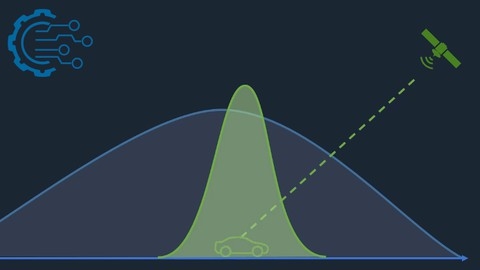Kalman filtering is a powerful statistical technique used to estimate the state of a dynamic system from a series of noisy measurements.
It finds applications in various fields, including robotics, navigation, finance, and weather forecasting.
By learning Kalman filtering, you can build systems capable of tracking objects, predicting future states, and making informed decisions based on uncertain data.
Finding a good Kalman filter course can be challenging, especially with the abundance of online learning platforms.
You’re likely seeking a course that provides a solid theoretical foundation while offering practical examples and hands-on exercises to solidify your understanding.
You might be struggling to find a course that strikes the right balance between mathematical rigor and practical application.
Based on our analysis, the Advanced Kalman Filtering and Sensor Fusion course on Udemy stands out as the best overall.
It delves deep into the intricacies of Kalman filtering, covering various types like Linear Kalman Filter, Extended Kalman Filter (EKF), and Unscented Kalman Filter (UKF).
The course includes simulations and practical examples to help you grasp the concepts effectively.
While the Advanced Kalman Filtering and Sensor Fusion course is our top recommendation, there are other excellent courses available on Udemy catering to different learning styles and needs.
Continue reading to explore other top-rated courses that might be a better fit for your specific requirements.
Advanced Kalman Filtering and Sensor Fusion
This course takes you on a journey starting with the fundamentals of sensor fusion.
You will discover how various sensors like cameras and GPS collaborate to provide a comprehensive understanding of a situation.
You will then delve into the Kalman Filter, a tool for merging data from these sensors and predicting future outcomes.
The course explores different types of Kalman Filters, including the Linear Kalman Filter, Extended Kalman Filter (EKF), and Unscented Kalman Filter (UKF).
You will gain hands-on experience through simulations, learning how these filters operate in practical scenarios.
The course covers crucial elements like probability density functions, Gaussian distributions, and representing data with mathematical models.
You will understand the prediction and update steps of the Kalman Filter, how to manage uncertainties and errors, and implement these filters using C++.
The course then advances to the EKF and UKF, which are particularly effective for handling complex systems.
You will explore concepts like Jacobians, numerical Jacobian calculations, and the unscented transformation, essential for constructing accurate models of real-world systems.
You will put your knowledge into practice by tackling a Capstone Project, where you will build a real-world project.
You will learn to handle sensor errors and biases, manage faulty data, and implement filters using real-world sensor data.
Data Fusion with Linear Kalman Filter
This course guides you through the essentials of probability and dynamic systems, all the way to the powerful Kalman filter.
You’ll begin by grasping the core ideas of probability, particularly Bayes Theorem, a vital tool for blending information from various sources.
You’ll then explore dynamic systems, learning to represent real-world processes using mathematical models.
Next, you’ll delve into least squares estimation, a technique for finding the best fit for data, which forms the basis for understanding the Kalman filter.
The course details the Kalman filter, exploring different types and how to implement them using Python.
Practical examples, like tracking an object in 2D space or estimating a pendulum’s motion, allow you to apply your skills to real-world situations.
You’ll also learn to fine-tune the Kalman filter for optimal performance.
This course provides a solid understanding of the Linear Kalman Filter and its applications.
Starting with probability and dynamic systems, you’ll gain the foundation needed to understand and utilize the Kalman filter effectively.
The course covers key concepts such as Bayes Theorem and its role in handling uncertain data and dives into representing and simulating real-world phenomena using mathematical models within dynamic systems.
You’ll learn how to translate these models into formats suitable for computer processing.
Autonomous Robots: Kalman Filter
This course on Autonomous Robots teaches you about the Kalman Filter, a powerful tool for predicting the future location of moving objects, even when there’s uncertainty.
You begin with the basics of filtering and learn how the Kalman Filter works.
You then move on to implementing the Kalman Filter in both one and two dimensions, using Python programming.
The course provides you with step-by-step instructions to set up your development environment using Conda, a popular tool for managing software packages.
You gain a solid understanding of how the Kalman Filter works, its mathematical foundations, and how to apply it to real-world situations.
You get hands-on experience through assignments where you implement the Kalman Filter yourself.
You learn to analyze data, identify and minimize the impact of noise, and fine-tune your filter’s settings for better accuracy.
These assignments help you understand how to use the Kalman Filter in practical scenarios.
Introduction to Kalman filter with Python
This course takes you from the basics of filtering to the power of Kalman filters, all using Python.
You start with simpler filters like the moving average filter and progress to the g filter and the g-h filter.
These early steps give you the foundation to understand the more complex Kalman filter.
You then dive deep into the Kalman filter, learning how it estimates a system’s state even with noisy measurements.
The course covers both the basic Kalman filter and the multi-dimensional version, which handles multiple variables at once.
You even learn how to implement these filters in Python, using real-world examples to solidify your understanding.
Finally, you explore the fascinating world of sensor fusion.
You discover how to combine data from multiple sensors using the Kalman filter, which leads to more accurate and reliable estimations.
This practical skill is highly sought after in many fields, including robotics and navigation.




